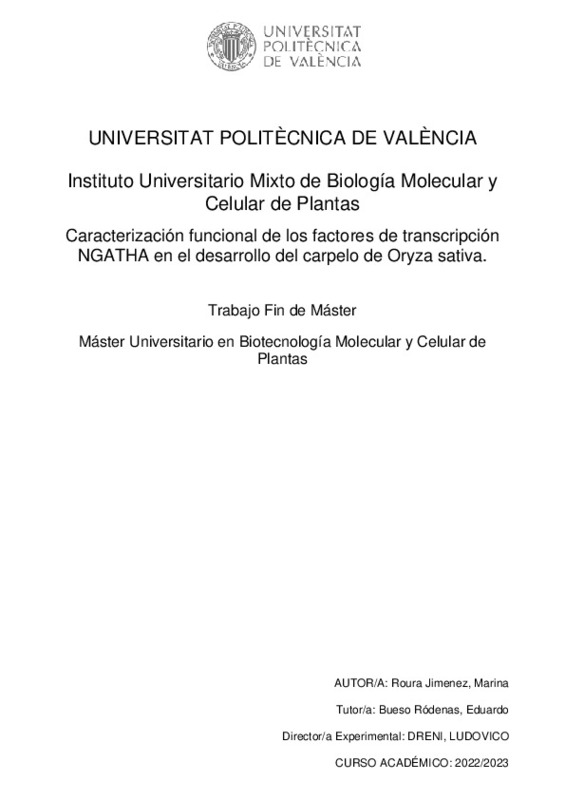|
Resumen:
|
[ES] Oryza sativa L. (arroz) es una de las fuentes alimentarias principales en el mundo. El desarrollo del meristemo de la inflorescencia del arroz, la ramificación de la panícula y el desarrollo de los órganos florales ...[+]
[ES] Oryza sativa L. (arroz) es una de las fuentes alimentarias principales en el mundo. El desarrollo del meristemo de la inflorescencia del arroz, la ramificación de la panícula y el desarrollo de los órganos florales son rasgos agronómicos importante para la mejora de este cultivo. Las familias de los factores de transcripción NGATHA (NGA) son esenciales en Arabidopsis para dirigir el desarrollo de los tejidos apicales del gineceo, el estilo, el estigma y la porción superior del tracto de transmisión. Sin embargo, no se conoce la función de los cuatro genes NGATHA (OsNGA1, OsNGA2, OsNGA3 y OsNGA4) que el laboratorio identificó en arroz, ni si estos genes tienen funciones conservadas evolutivamente en todas las angiospermas. Nuestro estudio tiene como objetivo caracterizar funcionalmente los genes OsNGA1/4 durante el desarrollo del estilo y estigma en arroz, mediante análisis genéticos y moleculares.
En nuestro trabajo, se procederá a la propagación y crecimiento de arroz de tipo silvestre y líneas mutantes simples, dobles, triples y cuádruple de los cuatro genes OsNGA (mutantes generados por CRISPR-Cas9 o inserción de T-DNA) y estudiar los defectos del desarrollo en el gineceo relacionados a la función. Se realizarán pruebas de PCR y secuenciación para validar el genotipo de los mutantes, además de histología y de microscopia óptica para analizar el fenotipo del carpelo. También se realizará un análisis de RNA-seq para ver en que procesos están involucrados estos genes.
Además, se realizarán estudios comparativos (evolución ¿ desarrollo) entre arroz, Arabidopsis y otras especies modelo, con el propósito de realizar estudios comparativos en el desarrollo del carpelo apical.
[-]
[EN] Oryza sativa L. (rice) is one of the main food sources in the world. The development of the meristem of the inflorescence of rice, the branching of the panicle and the development of the floral organs are important ...[+]
[EN] Oryza sativa L. (rice) is one of the main food sources in the world. The development of the meristem of the inflorescence of rice, the branching of the panicle and the development of the floral organs are important agronomic traits for the improvement of this crop. The NGATHA (NGA) families of transcription factors are essential in Arabidopsis to direct the development of the apical tissues of the gynoecium, style, stigma, and upper portion of the transmission tract. However, the function of the four NGATHA genes (OsNGA1, OsNGA2, OsNGA3 and OsNGA4) that the lab identified in rice is not known, nor is it known whether these genes have evolutionarily conserved functions in all angiosperms. Our study aims to functionally characterize the OsNGA1/4 genes during style and stigma development in rice, through genetic and molecular analyses.
In our work, we will proceed to the propagation and growth of wild-type rice and single, double, triple and quadruple mutant lines of the four OsNGA genes (mutants generated by CRISPR-Cas9 or T-DNA insertion) and to study the defects of the development in the gynoecium related to the function. PCR and sequencing tests will be performed to validate the genotype of the mutants, as well as histology and light microscopy to analyze the carpel phenotype. An RNA-seq analysis will also be performed to see in which processes these genes are involved.
In addition, comparative studies (evolution - development) will be carried out between rice, Arabidopsis and other model species, with the purpose of carrying out comparative studies in the development of the apical carpel.
[-]
|







